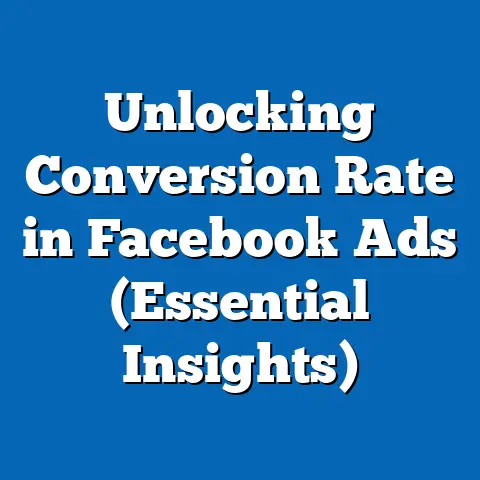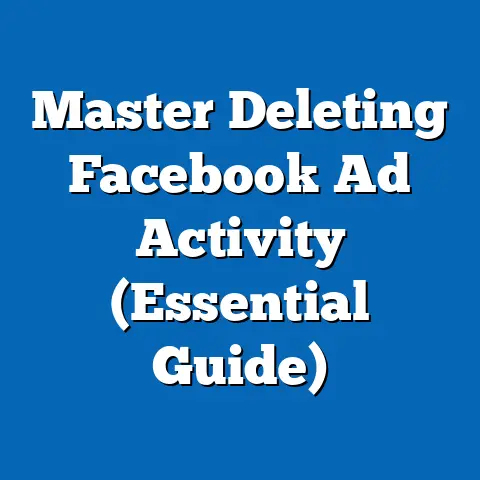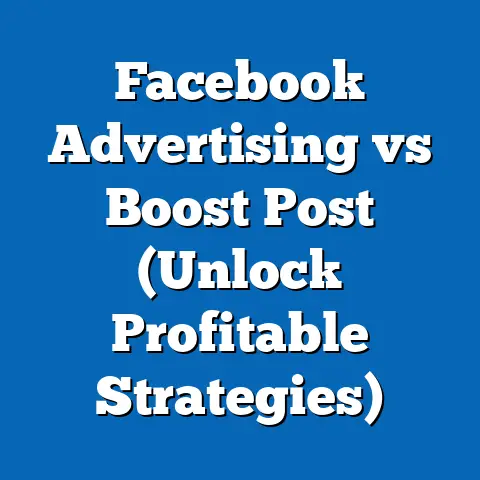Unmasking Facebook Ad Scams (Essential Insights for Marketers)
Many marketers jump into Facebook advertising believing it’s a guaranteed path to leads and revenue. I know I did when I first started! The reality, however, is that this powerful platform is unfortunately also a playground for scammers. These scams can undermine even the most carefully crafted campaigns, costing businesses money, time, and reputation. I’ve seen it happen firsthand, and it’s not pretty.
The digital world is constantly evolving, and so are the tactics used by online fraudsters. They target both advertisers and users, leading to substantial financial losses and damaged brand reputations. That’s why I believe it’s vital for marketers to arm themselves with knowledge about these scams. Understanding the threats is the first step to protecting your investments and improving your overall advertising strategies. This isn’t just about avoiding losses; it’s about ensuring your marketing efforts are genuine, effective, and build trust with your audience.
In this article, I’ll delve into the murky world of Facebook ad scams, providing you with the essential insights and actionable strategies you need to stay safe and get the most out of your advertising budget. Let’s get started!
Understanding Facebook Ad Scams
Defining Facebook Ad Scams
So, what exactly constitutes a Facebook ad scam? It’s a broad term that encompasses any deceptive or fraudulent activity related to advertising on the platform. These scams often aim to:
- Steal money from advertisers: By fraudulently inflating ad costs or diverting budgets to fake sources.
- Collect personal information from users: Through deceptive ads that lead to phishing websites or malware downloads.
- Promote fake or low-quality products/services: Misleading consumers and damaging brand trust.
Some common examples of Facebook ad scams include:
- Click fraud: Generating fake clicks on ads to deplete the advertiser’s budget.
- Fake ad accounts: Creating and using fraudulent accounts to run unauthorized or misleading ads.
- Misleading ad content: Using deceptive claims or images to attract clicks and drive traffic to scam websites.
- Malware distribution: Embedding malicious links in ads that lead to the installation of viruses or other harmful software.
- Brand impersonation: Creating fake ads that mimic legitimate brands to deceive consumers.
Statistics and Impact
The prevalence of Facebook ad scams is a growing concern. While Facebook actively combats these scams, they continue to evolve and pose a significant threat. Here are some key statistics that highlight the impact:
- Financial Losses: According to a report by Juniper Research, ad fraud is estimated to cost advertisers globally over $100 billion annually, and a significant portion of this occurs on social media platforms like Facebook.
- Click Fraud Rates: Studies have shown that click fraud rates on Facebook can range from 2% to as high as 20%, depending on the industry and campaign settings.
- User Trust: A survey by Pew Research Center found that 72% of Americans are concerned about the spread of false information online, which directly impacts their trust in advertising and brands.
These scams not only result in financial losses but also damage brand reputation, erode consumer trust, and distort campaign performance metrics. When your ad budget is being drained by fraudulent clicks, it’s impossible to accurately measure the effectiveness of your campaigns and make informed decisions.
Takeaway: Understanding the definition and scope of Facebook ad scams is the first step in protecting your business. Recognizing the financial and reputational risks involved will motivate you to implement proactive measures.
Types of Facebook Ad Scams
Facebook ad scams come in various forms, each with its own unique tactics and potential consequences. Here, I’ll break down some of the most common types:
Fake Accounts and Profiles
Scammers often create fake accounts and profiles to run fraudulent ad campaigns. These accounts may use stolen or generated profile pictures, fake names, and fabricated personal information. The goal is to appear legitimate and avoid detection by Facebook’s security measures.
These fake accounts are then used to:
- Run unauthorized ads: Promoting fake products, phishing schemes, or malware.
- Inflate ad engagement: Generating fake likes, comments, and shares to make ads appear more popular and trustworthy.
- Spread misinformation: Promoting false or misleading content to influence public opinion or drive traffic to scam websites.
Example: I once encountered a campaign where a fake account was used to promote a “limited-time” discount on a popular tech gadget. The ad looked legitimate, but the landing page was a phishing site designed to steal credit card information.
Click Fraud
Click fraud is a particularly insidious type of ad scam where scammers generate fake clicks on ads to deplete the advertiser’s budget. This can be done using bots, click farms, or even by incentivizing users to click on ads repeatedly.
The consequences of click fraud include:
- Wasted ad spend: Your budget is being used to pay for fake clicks that don’t lead to conversions.
- Inaccurate campaign data: Inflated click-through rates (CTR) and other metrics make it difficult to assess the true performance of your ads.
- Reduced ROI: Your return on investment (ROI) is significantly lower because you’re paying for clicks that don’t generate revenue.
Example: I worked with a client who noticed a sudden spike in clicks on their Facebook ads, but their website traffic remained relatively unchanged. After investigating, we discovered that a significant portion of the clicks were coming from suspicious IP addresses and were likely the result of click fraud.
Phishing Schemes
Phishing schemes involve using Facebook ads to trick users into revealing personal information or financial details. These ads often mimic legitimate brands or offer enticing deals to lure unsuspecting users.
When a user clicks on a phishing ad, they’re typically redirected to a fake website that looks identical to a real one. The website then prompts the user to enter their login credentials, credit card information, or other sensitive data.
Example: I saw an ad that offered a “free” gift card from a major retailer. When I clicked on the ad, I was taken to a website that looked just like the retailer’s official site. However, the URL was slightly different, and the website asked me to enter my credit card information to “verify” my identity.
Takeaway: Being aware of these different types of Facebook ad scams is crucial for recognizing and avoiding them. Regularly monitor your campaigns for suspicious activity and be wary of ads that seem too good to be true.
Recognizing Red Flags
The ability to spot potential scams is your first line of defense. Here are some common red flags to watch out for:
Common Warning Signs
- Unrealistic Promises: Be wary of ads that promise guaranteed results, overnight success, or ridiculously low prices. If it sounds too good to be true, it probably is.
- Poor Grammar and Spelling: Scammers often lack attention to detail, and their ads may contain grammatical errors, typos, or awkward phrasing.
- Lack of Transparency: Legitimate businesses are usually transparent about their products, services, and contact information. If an ad lacks these details or provides vague or misleading information, it’s a red flag.
- Suspicious URLs: Check the URL of the landing page before clicking on an ad. Look for misspellings, unusual domain extensions, or redirects to unfamiliar websites.
- High Click-Through Rates (CTR) with Low Conversion Rates: If your ads are generating a lot of clicks but few conversions, it could be a sign of click fraud.
- Sudden Spikes in Traffic from Unusual Sources: Monitor your website traffic for unexpected surges from unfamiliar countries or IP addresses.
- Requests for Sensitive Information: Be cautious of ads that ask for your credit card information, social security number, or other sensitive data upfront.
Case Studies
Let’s look at a couple of real-life examples of businesses that fell victim to Facebook ad scams:
- Small E-commerce Business: A small e-commerce business launched a Facebook ad campaign to promote a new product. They noticed a large number of clicks on their ads but very few sales. After investigating, they discovered that a competitor was using bots to click on their ads and deplete their budget. This not only wasted their ad spend but also made it difficult to reach their target audience.
- Local Restaurant: A local restaurant ran a Facebook ad offering a discount coupon. The ad was cloned by scammers who redirected users to a fake website that asked for their credit card information to “verify” the coupon. This damaged the restaurant’s reputation and led to a loss of customers.
These cases highlight the importance of being vigilant and taking proactive measures to protect your business from Facebook ad scams.
Takeaway: By recognizing these red flags, you can significantly reduce your risk of falling victim to ad scams. Regularly monitor your campaigns and be skeptical of ads that seem suspicious or too good to be true.
The Role of Facebook in Combating Scams
Facebook has a responsibility to protect its users and advertisers from ad scams. Here’s a look at the measures they’ve implemented:
Facebook’s Policies and Measures
- Advertising Policies: Facebook has strict advertising policies that prohibit misleading, deceptive, or fraudulent content. Ads that violate these policies are subject to removal.
- Review Processes: All ads submitted to Facebook undergo a review process to ensure they comply with the advertising policies. This process involves both automated and manual checks.
- User Reporting Mechanisms: Facebook provides users with tools to report ads that they believe are scams or violate the advertising policies.
- Machine Learning and AI: Facebook uses machine learning and artificial intelligence (AI) to detect and remove fraudulent accounts and ads.
- Account Verification: Facebook offers account verification badges to help users identify legitimate businesses and organizations.
Limitations of Facebook’s Efforts
Despite these efforts, Facebook faces significant challenges in fully eradicating ad scams. Some of the limitations include:
- The Scale of the Platform: Facebook has billions of users and millions of advertisers, making it difficult to monitor all ad activity effectively.
- Evolving Scam Tactics: Scammers are constantly developing new and sophisticated tactics to evade detection.
- Automated Systems Can Make Mistakes: Automated review systems are not always accurate and may sometimes flag legitimate ads as scams.
- Delayed Response Times: It can take time for Facebook to review and remove fraudulent ads, during which time they can still cause damage.
Takeaway: While Facebook is taking steps to combat ad scams, it’s important to remember that they are not foolproof. Advertisers must also take responsibility for protecting themselves.
Protecting Your Business
The best defense against Facebook ad scams is a proactive approach. Here are some best practices you can implement:
Best Practices for Marketers
- Thorough Research: Before running any ad campaign, research the products, services, and businesses you’re promoting. Ensure they are legitimate and trustworthy.
- Monitor Ad Performance: Regularly monitor your ad performance metrics, such as CTR, conversion rates, and website traffic. Look for any unusual patterns or anomalies that could indicate click fraud or other scams.
- Verify Ad Accounts: Make sure you’re only working with verified ad accounts and that you have full control over your ad campaigns.
- Use Strong Passwords and Two-Factor Authentication: Protect your Facebook account with a strong password and enable two-factor authentication for added security.
- Be Cautious of Third-Party Apps and Services: Be wary of third-party apps and services that claim to boost your ad performance or automate your campaigns. Some of these may be scams or contain malware.
- Educate Your Team: Train your marketing team on how to recognize and avoid Facebook ad scams.
- Stay Up-to-Date: Stay informed about the latest scam tactics and best practices for protecting your business.
Leveraging Tools and Resources
- Facebook Ads Manager: Use Facebook Ads Manager to monitor your ad performance, track your budget, and identify any suspicious activity.
- Facebook Pixel: Install the Facebook Pixel on your website to track conversions and measure the effectiveness of your ad campaigns.
- Google Analytics: Use Google Analytics to monitor your website traffic and identify any unusual sources or patterns.
- Click Fraud Detection Tools: Consider using third-party click fraud detection tools to monitor your ad campaigns and identify fraudulent clicks.
- Facebook’s Reporting Tools: Use Facebook’s reporting tools to report any ads or accounts that you believe are scams or violate the advertising policies.
Takeaway: By following these best practices and leveraging the available tools and resources, you can significantly reduce your risk of falling victim to Facebook ad scams.
Conclusion
Facebook advertising can be a powerful tool for reaching your target audience and growing your business. However, it’s important to be aware of the risks associated with ad scams and take proactive steps to protect your investments.
Summarize Key Takeaways
- Facebook ad scams are a growing problem that can result in financial losses, damaged brand reputation, and inaccurate campaign data.
- Common types of ad scams include fake accounts, click fraud, and phishing schemes.
- Recognizing red flags such as unrealistic promises, poor grammar, and suspicious URLs is crucial for avoiding scams.
- While Facebook is taking steps to combat ad scams, advertisers must also take responsibility for protecting themselves.
- Best practices for protecting your business include thorough research, monitoring ad performance, and verifying ad accounts.
Call to Action
Now that you’re armed with the knowledge and tools to combat Facebook ad scams, I encourage you to take action! Educate yourself and your team about the latest scam tactics. Share your insights and experiences with other marketers to foster a community of informed advertisers. By working together, we can make Facebook a safer and more effective platform for everyone.
Don’t let the fear of scams paralyze you. Embrace the power of Facebook advertising, but do so with caution, vigilance, and a commitment to protecting your business. Your success depends on it!






